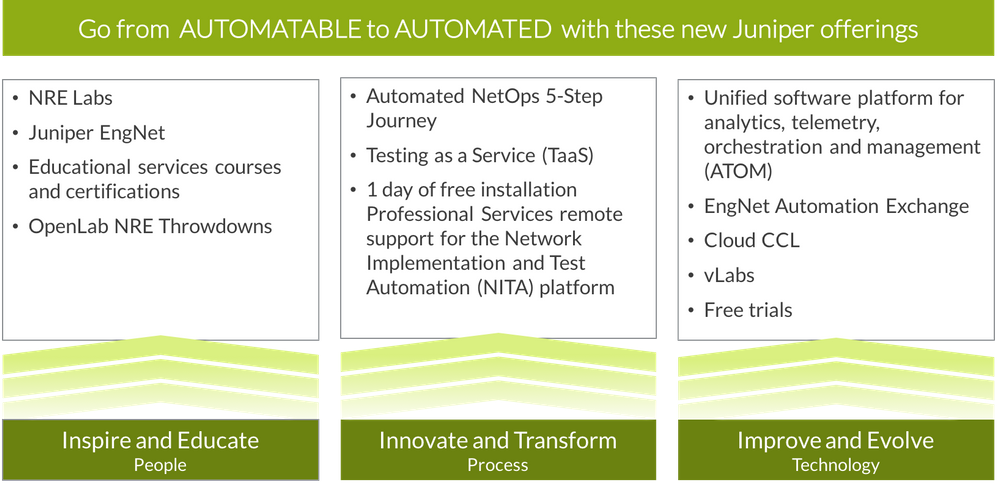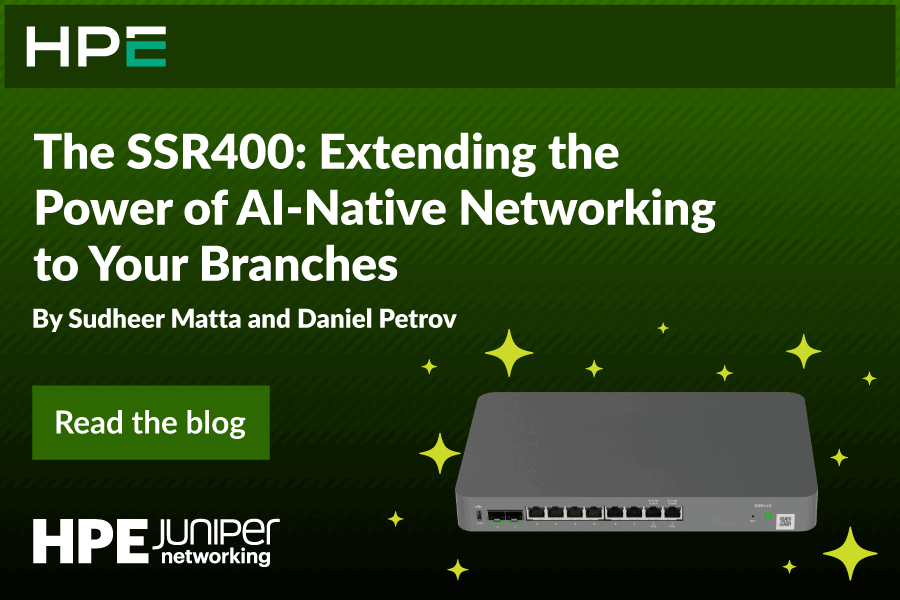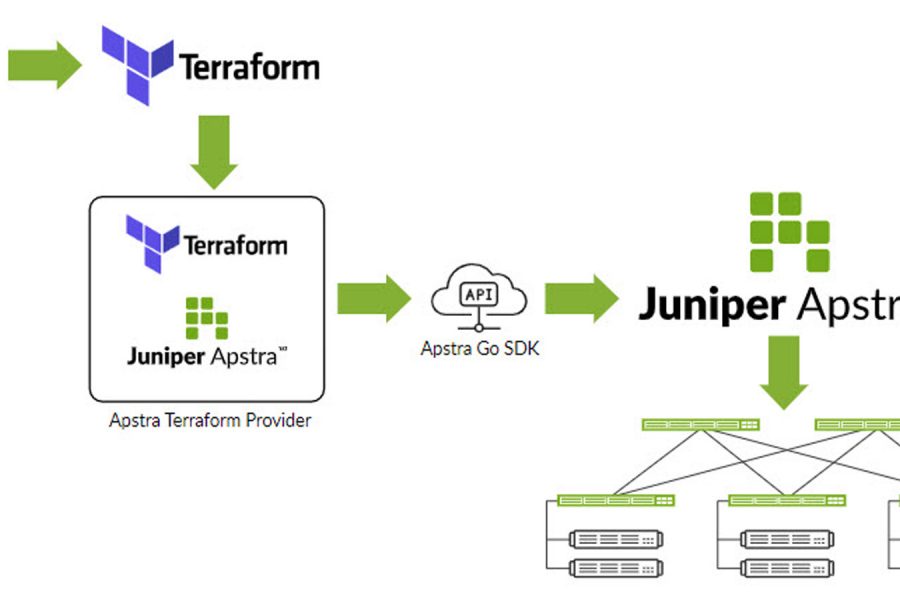Today, at NXTWORK Americas, Juniper Networks announced and demonstrated a holistic set of offerings to usher in a new era of operational simplicity through automation. While there’s a long list of news, specifically we’re turning the network automation precedent on its head. Instead of sensationalizing new products, technologies, tools and APIs, we’re focused on the network engineering, people and processes that will take us into the automated future.

In a history of network automation heavy with colorful conversations and complex architectures, our announcements today supply simplicity and a straightforward path for network engineers.
The failure to fully attain automated network operations isn’t from lack of attention on network automation, so it’s worth reflection.
To start, automation must be approached as the bilateral challenge that it is. Like Dev and Ops, there are builders and users, and success must be measured by the end state of automated operations, not by how many automation tools and APIs come off of the builders’ assembly line.
When it comes to vendors as builders, our competitors fall far short on architecture. Quite simply, you cannot automate a mess and you cannot automate well across many platforms siloed in each network domain or blindly stacked upon each other.
There are workflows and intents common across many places in the network and we get economies of engineering scale and reuse through common platforms and specifications. A unified architecture for automation is a point of emphasis in every Juniper product. Remember One Junos? Today, we’re excited to reveal a new unified platform that underpins Juniper’s software-defined products. And this is only one side of the story.
The other side, where the larger industry narrative falls short is even more significant because it has failed to adequately consider the NetOps side of the two-way street to automation—the people and processes of NetOps. Occasionally, the narrative is more severely uneducated or crass when it puts forward implications that the purpose of automation is to subvert operators.
Automation is typically marketed as the magic that will bond the network vendor (Dev) and the customer operator (Ops), but the reality for most network operators is that decades of dedication to more automation technology and tooling has hardly evolved the ops side of this relationship. SDN, NFV, disaggregation, new products, new tools and more APIs keep the narrative whirling, but they focus on what the vendor is delivering, instead of how NetOps consumes and runs it.
The consumption of automation is the contemporary networking challenge.
Our mission of Engineering Simplicity spans our own innovations, certainly our products, but also extends to Juniper playing an active role in improving network operations in the hands of our customers. Especially in the enterprise, if secure and automated multicloud is the destination, we must move the industry past automatable to automated. This begins deep within operations with a new approach, new goals and a new role.
Approaching Automation as Engineering
If we look at the operational bright spots in IT for a fresh perspective, the best automated operations producing simplicity start with people and process, not new tools and tricks. This kind of transformation—reliability engineering—is just as openly accessible as open-source software. You cannot ‘git clone’ it, but you can begin merging change into your teams today.
From my time at Google, I’m deeply acquainted with site reliability engineering (SRE), and the book by the same name, openly prescribes how engineering can truly bridge Dev and Ops managing to metrics of reliability. My 2016 paper is a deep dive into these principles in action, running Google’s networks. In summary, whether you prefer to think in terms of DevOps or SRE, the hallmark of operational success is the same: engineering applied to ops, as well as continuous improvement by automating in lessons from failures and observations.
Forrester has recently reported how mainstream enterprises are applying SRE in their IT infrastructure and operations. Nowadays, network reliability engineering (NRE) is catching on as the practices applied to NetOps, and Juniper has hitched our wagon to this positive trend and featured it in past blogs and the 5-step journey to automated network operations.
NRE concentrates on engineering as the approach to automation and the ops-familiar truth that availability is a prerequisite to any other measure of success.
Now we’re taking the next steps with new training to enable network engineers to grow, practice and sharpen expertise with new technologies, services and open-source projects that strongly align with proven continuous processes like gitOps, networks as code, pipelining and testing.
Speed is a Byproduct
The future belongs to the fast, and it’s hard to keep up. But if we put the economies of speed ahead of reliability, the speed may never even matter. Just like a rocket’s escape velocity never matters if it explodes right after launch, a reliability-first focus will ensure we get far enough to become fast.
DevOps research has shown that moving faster can counter-intuitively produce more successful ops. But forced speed without automation is treacherous. Safe speed and agility is tended over time by people, processes and architectures that automate in ever-safer, more reliable change, which is usually in small increments.
Classic network operations is a tradeoff between efficiency, reliability and agility. Automation done right is the only way to achieve efficiency, reliability and agility together. If you want to reduce deployment anxiety, maintenance window misadventures, ad hoc change and drift, then NRE is a good approach to the kind of automating that puts reliability, inclusive of security, ahead of sheer speed and possible dangers that you can’t afford in your multicloud infrastructure—the network. In building a reliable network foundation and the network agility that follows, you will provide upstack SREs and applications teams with service levels they can depend on and technology and business agility as a byproduct.
In Terms of Automation, Ironically, Humans are Heroes
It’s tempting to put technology front and center in automation conversations. And while Juniper was first to tout a more autonomous self-driving network vision, we’ve always maintained that network engineers are heroes in their NetOps journey.
Narratives of the future that paint a hapless picture, eliminating humans operators, have it backward. In fact, SRE and NRE are often described as roles (engineer instead of engineering), placing people at the core of change, garnering them more attention, more responsibility and more reward.
In the future, network engineers will be more technologist than technician. They’ll touch a scant amount of device CLI, but it won’t be all GUIs—they’ll shift to APIs that drive higher-order workflows and gitOps changes. No matter the provisioning altitude of intent and the amount of autonomous sensors, logic and actuators in a system, humans will be the key interface that drive changes and need information about the system state for data-driven decision making and service-level observability.
The role of automation technology is to reduce the daily toil of repetitive tasks that leads to unintended mistakes. It also provides the guardrails to ensure SLA guarantees. SLAs and reliability are not left to caffeine-powered individual heroics, but are achieved through well-trained automation heroes, also known as NREs.
Making Automation Accessible to Every Engineer
Since a critical part of automated operations is the individual engineers and processes they follow, Juniper has put deliberate investment into these areas marked by today’s news, introducing many formal and informal training programs, cloud-based lab services, testing as a service, free trials, live throwdowns and Juniper EngNet, a new Engineering Network community.
The EngNet site hosts builder resources, learning resources, a catalog of useful network automation tools and an open forum to communicate and collaborate. While Juniper unveils this new community with enthusiasm, we also aim to be the catalyst that initiates the journey for individuals to automators and NREs.
One of the inhibitors that NetOps teams and individuals face is knowing where to start. Our 5-step journey provides them a map, a direction and their location, but most of our customers are at step one today without momentum or a detailed plan.
At the outset, when one thinks about what to automate, the answer cannot be “the network.” Specifics about workflows are prerequisite to automating them. After network engineers know and document their workflows, then they can begin to cut their teeth by employing tools and coding.
To ease engineers into automating workflows, Juniper is building NRE Labs—a completely in-browser experience for network automation learning in bite-sized exercises. It is sponsored by Juniper and completely free and useable to customers and non-customers alike seeking to ignite new passions or enable them to get more practice automating. NRE Labs is in tech preview, being developed as an open-source project built on Kubernetes and crafted with the unplugged feel of lessons by and for network engineers. Contributions are welcome!
We are also launching new formal education services trainings and certifications. Building on the success of the Junos Platform Automation and DevOps course, we’re expanding our training services to now include an automation training path through a new introductory level, the existing intermediate level and new advanced level. Paired with the three training tiers, we have new exams and Juniper certifications at the Associate (JNCIA) and Specialist (JNCIS) levels.
Lab Testing
Labs are traditionally the place of engineering experimentation, but also serve as an important testing ground for safe failures, stress testing and change testing or staging. Failures occur more often around times of operational change, and with modern multicloud networks and today’s fast pace of business, continuous incremental evolution is critical to keep up. Test automation and verification play a critical role in helping network engineers move quickly while preventing and avoiding failures in production.
Testing as a Service is a recent addition to Juniper’s professional services. Previously, we used our own Customer Certification Labs (CCL) to realize Testing as a Service. We’re now pleased to offer it more widely on our new Cloud CCL platform. Customers logging in to Cloud CCL can also consume it entirely by self-service and on-demand.
In addition to supporting virtual Junos OS devices (vMX, vSRX, vQFX) and our other products (Junos Space, NorthStar, JSA, etc.) on Cloud CCL, users can access traffic generators and the Linux automation systems provisioned with the Network Implementation and Test Automation (NITA) framework. NITA is comprised of continuous integration and infrastructure-as-code open-source tools: GitLab, Ansible, Robot Framework and Jenkins. The NITA framework is also what underpins our recently announced services for Automated Lab Testing and Deployment.
With NITA on Cloud CCL users can get started with test automation right away, using our sample test-scripts repository, writing their own tests and jumpstarting their test suite with Juniper professional services. To customers with their own network labs, we’re also pleased to begin offering one day of free installation support for NITA on their own servers. Contact your Juniper sales representative to get started.
Zero Barriers to Entry
Adding to our repertoire of free trials for vMX, vSRX, Sky ATP and Contrail, we’re now also introducing the vQFX trial, a Juniper-hosted AppFormix trial, and a sales- or partner-curated trial of the NITA framework. Look for these and more at juniper.net/trial.
Based on the same system as Cloud CCL, we’re excited that vLabs is through beta and now open for anyone to easily explore ready-made topologies or single-node setups with vMX, vSRX and vQFX. vLabs will also help to demonstrate scenarios in our documentation, techwiki and blogs.
Open Engineering
For years, Juniper has set the bar for open engineering. OpenLab, The Center for Juniper Innovation, has been an industry hub for academics and professionals alike to learn and practice networking with open source, open APIs and open standards. As we recently hosted Juniper NXTWORK events in Australia, we also recently opened our newest OpenLab location in Melbourne, Australia.
With today’s release of new services, labs and free trials, you have more to explore on your automation adventures. In conjunction with our OpenLab Network Automation Throwdown Program that offers network engineers hands-on time building automation with our mentors, we are scheduling new events for you to join us in person to use NRE Labs and Cloud CCL to improve your network reliability engineering by design with automation.
One More Thing… One Architecture
To complement our outward focus on advancing NetOps and network engineers, we’re also inwardly focused on our own engineering and architecture.
Other vendors often deliver point solutions where software platform divergence and siloed duplication greatly impedes uniform interfaces, well-tested quality, large user communities and most of all, operational simplicity.
Juniper’s reputation as the provider of most automatable network devices has been largely facilitated by avoiding this. Instead of adding one more thing, we steadfastly converged on just one thing: One Junos—the simplicity of one network operating system across routing, switching and security systems.
With the rise of cloud-native and cloud-scale computing, Juniper has newly dedicated ourselves to also sticking to One Platform. Just like all software today, our SDN and automation bots need a strong, modern architecture for DevOps-like agility, reliability, scale, performance, analytics, security and especially multicloud portability. Thus, we have unified and solidified the foundation for Juniper at-scale software on a hardened Kubernetes-based platform, making the innovations you already trust to power your network even better.
Inside Juniper, we call this platform ATOM for analytics, telemetry, orchestration and management.

























